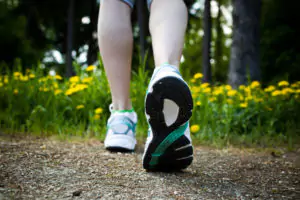One of the most common complaints that walkers or runners come to us with is heel pain.
Heel pain usually affects the underside or back of your heel. Either the tendon or plantar fascia across the bottom of the foot becomes tight or the Achilles tendon on the back of the heel pulls on the heel bone. Either way, the inflammation and tightness this causes is very painful.
Unfortunately, heel pain can significantly interfere with your normal activities, particularly exercise. In a viscous cycle, the everyday movements that you perform on your feet continue to create trauma to this area and delay the healing process. So often, our clients are told to rest. They may even be put into a boot or brace to allow the injury to recover.
There are two problems with this “let it rest” solution for heel pain. First of all, it’s usually a chronic injury that comes from over use over a long period of time. After a period of rest, clients resume their activity level and the pain returns. Second, when your feet hurt, it’s really difficulty to truly rest them. We need to get around in our everyday lives and this requires our feet.
So, if complete rest isn’t really a reasonable option, what can we due to run, walk, and live without heel pain?
1. Stretch Your Foot and Ankle
It’s important to keep tissues gently moving so scar tissue doesn’t build up during the healing process. Rolling the bottom of your foot with a tennis ball through the arch several times per day can be beneficial. You will also benefit from stretching the back of the heel and calf muscles to keep them from stiffening up.
2. Cross Train
Occasionally replace your run or hike with a swim or elliptical session. This gives your foot a little break from pounding the pavement. If you are used to walking on hills and uneven terrain, a swap for a flat track for awhile can even help relieve some strain and heel pressure.
3. Use Ice Daily
After a run, long walk, or at the end of the day ice the bottom of your foot. This helps alleviate pain, decrease inflammation, and stimulate the healing process. Our favorite way to do this is to freeze a plastic water bottle and roll in under your foot for about 10 minutes.
4. Warm Up
Heel pain is often most painful first thing in the morning. Before stepping out of bed, warm up your foot and ankle. Perform ankle circles or write the alphabet with your toes. This will help loosen the tissues that stiffened overnight. The tissues will then be ready for the added pressure of standing and moving.
5. Wear Supportive Shoes
Supportive footwear is critical to treating or preventing heel pain. Flimsy flats, high heels, or flip flops don’t provide the protection your foot needs as it heals. A supportive, good fitting shoe positions your foot in a way that does not cause extra stress as you move throughout your day.
6. Move Often
Standing still for long periods of time increases stiffness in your foot and ankle, resulting in pain when you get moving again. Ideally, you will move your body at least every 20 minutes. If you must sit or stand in one place, be sure to move your ankle up and down or in circles frequently.
7. Treat the Root cause
Physical therapy is the fastest way to eliminate heel pain and get you back to the activities you love. Our therapists utilize manual therapy techniques to loosen the stiff areas and strengthen the weak spots. You might even be surprised after a thorough evaluation that the root cause of your heel pain isn’t even in your foot at all. Addressing weakness in the lower leg and all the way to the hips and low back is often necessary.
If you try steps 1 through 6 and don’t see results in a few days, it’s time to start thinking about step 7. In fact, this step may be the easiest. Just go HERE and fill out a short inquiry form and a physical therapist will give you a call to discuss your concerns and offer individualized solutions. Get your FREE discovery call TODAY.


